Mme Isaac Péreire started her first flush of perfumed roses about a week ago. She will continue to flower for months but this first flowering is the most dense and the most welcome and the perfume drifts over the patio to be enjoyed with cups of coffee in the sun.
She is being trained round the corner and with the help of the white jasmine does her best to conceal the down pipe.
She is also appreciated by the bumble bees who disappear inside. The buzz of the bumble bees reverberates through the flower until they once more reappear and fly off. This is an early bumble bee (Bombus pratorum). I have seen a lot of them this year but it must be about the end of their season now.
This week I noticed another old favourite, the bee orchid (Ophrys apifera) while I was removing the faded forget-me-nots. In fact I was lucky I spotted it. I managed to rescue another one which had been weighed down by the forget-me-nots but that had got quite bent.
They are not dependant on bees for pollination but I would love to get a photograph with a bee, nevertheless. This one is not in the same place as the one that had appeared last year, so they are perhaps seeding themselves.
I had given up growing Aquilegia from seed this year.
I had taken seed from friends’ gardens, I had been given a presents of packet seeds and I only managed a few pathetic specimens.
Those pathetic specimens must have taken things into their own hands and re-seeded in places of their own choice and I have some decent plants for the first time.
A new Peony bought on a whim and without a name has flowered and produced three flowers that open and close at night time.
They will not re-flower like roses but I have no objection to just having their flowers for a short time every year.
Another first this week is the first flower on a Viburnum I bought while on holiday is Gascony a few years ago. It was supposedly an unusual Viburnum but I could not find the name on the web and I have now lost it completely. It will have to remain my no-name Viburnum.
One of the last fruit trees to flower is the Medlar which has an attractive white blossom.
The Medlar flowers faithfully every year and gives us fruit but our Olive tree has surprised us by producing flowers for the first time. I presume the mild winter has coaxed it into trying but I am not sure whether we could ever have proper fruit here.
Another first flowering this year is an Acacia tree grown from seed by my husband from a beautifully perfumed tree growing in a multi-storey car park in Guildford! The flowers were highly perfumed which attracted him but we are also surrounded by Acacias in the woods around here. Still this is a very special hand-grown one!
I bought this Fremontodendron as a tiny plant on a love at first sight basis. It has grown and produces flowers every year but it does not seem to fit in. It is a plant in the wrong place but I don’t know what the correct place might be.
At least it provides succour for the wild bees as this little Halictid bears witness. I must promise not to buy any more plants without first thinking about where they are to go.
The double orange poppies are the first to appear in the garden and are highly appreciated by bees and bumble bees alike. They are not aggressive creatures and ignore any other foragers on the flowers.
You need to peer to find the Hoopoe but he appeared in the garden three days ago and is a herald of summer to me. He walked out of the garden closely followed by me and my camera but he never let me get close enough for a good photograph.
My husband had spotted him at the end of March on the roof but I was trying for a closer shot.
The cuckoo heralds the spring but by May his call is starting to get monotonous and I begin to harbour uncharitable thoughts about his contribution to the sounds of nature.
Roll on summer!




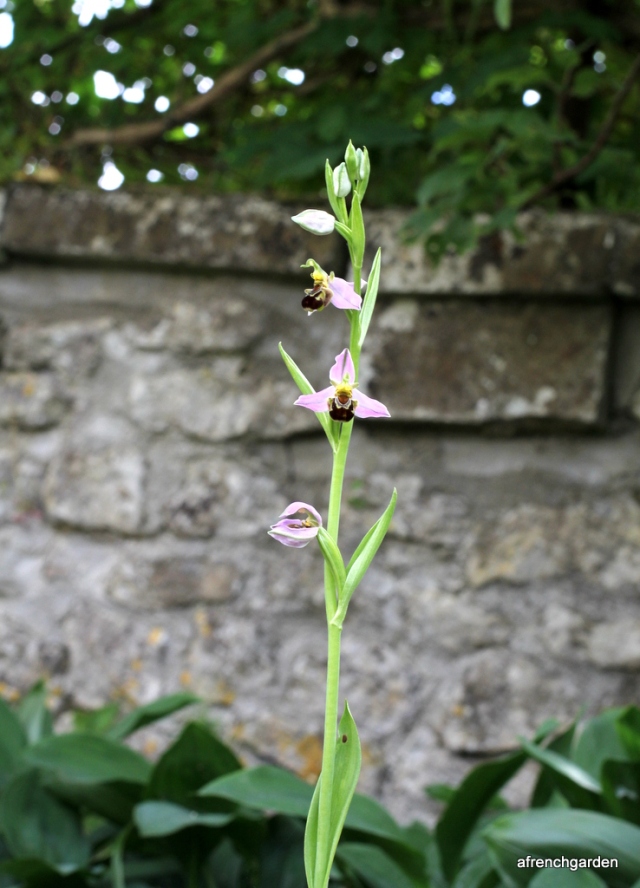
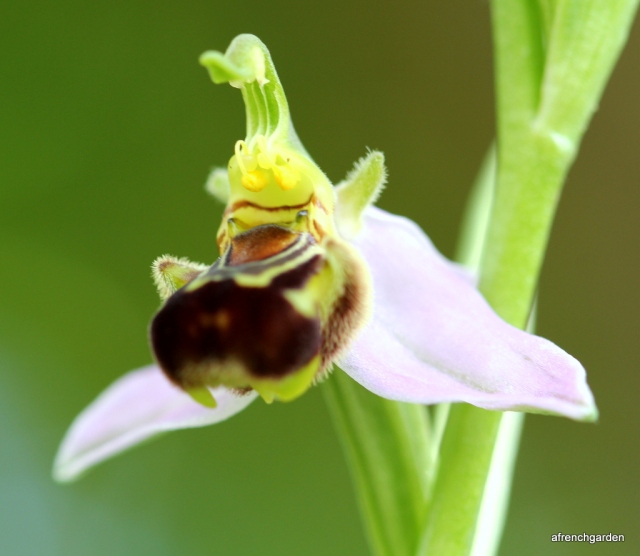
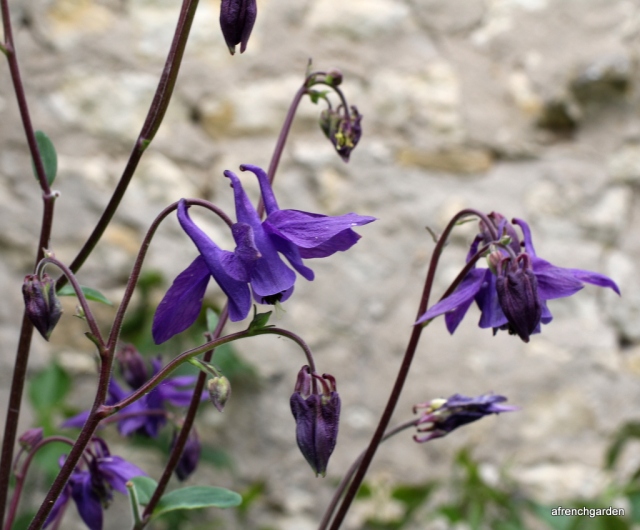

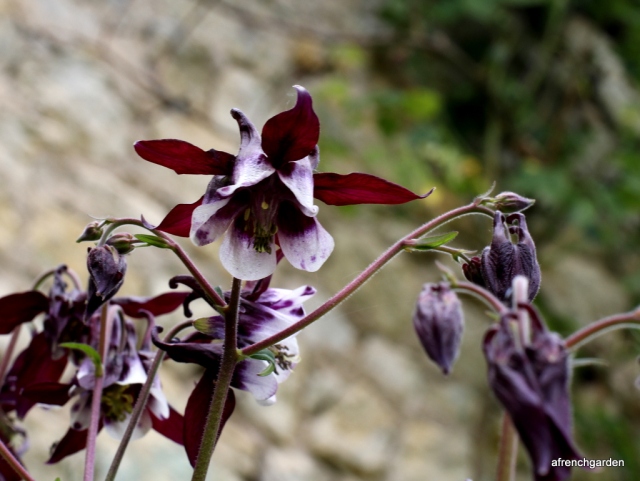


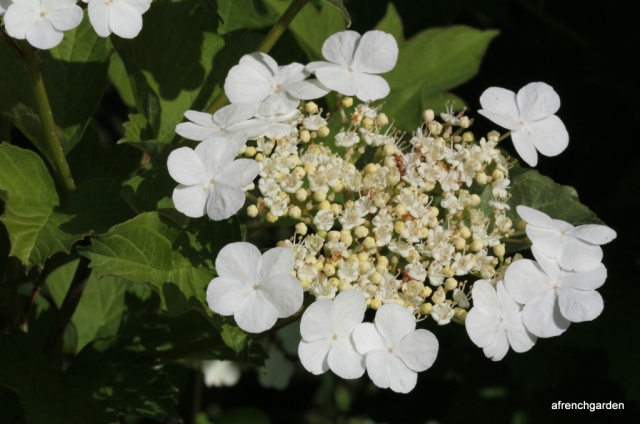
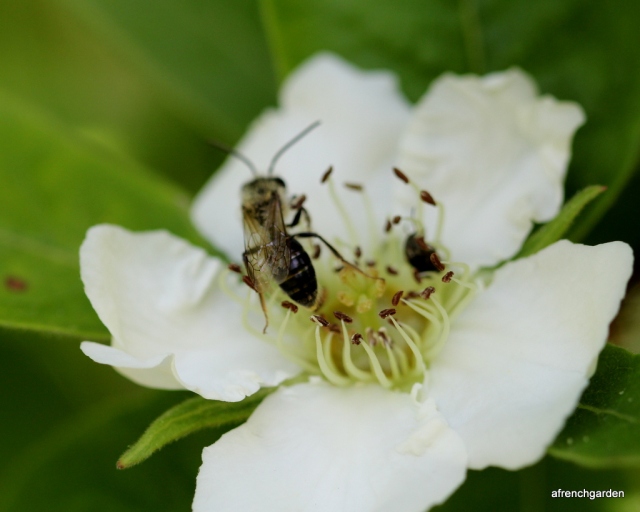
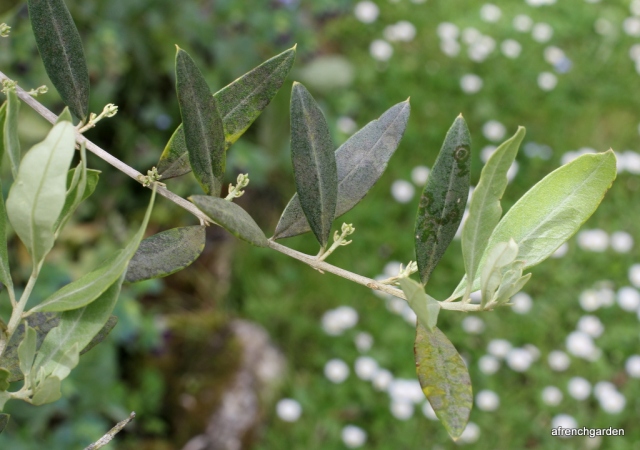

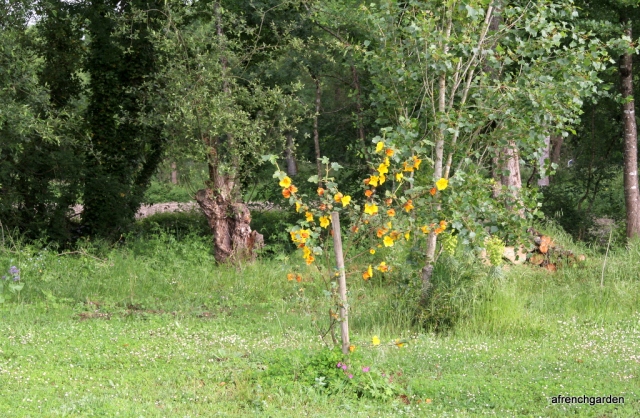

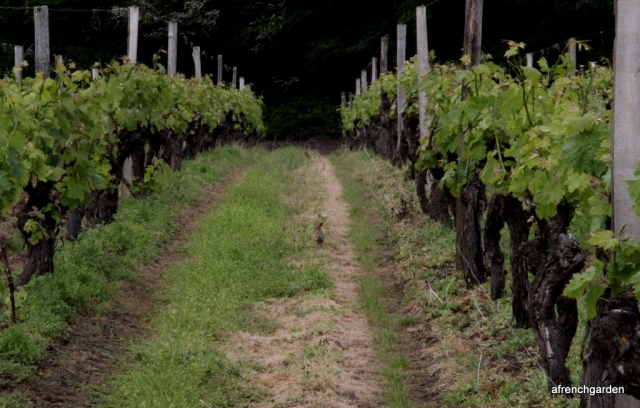
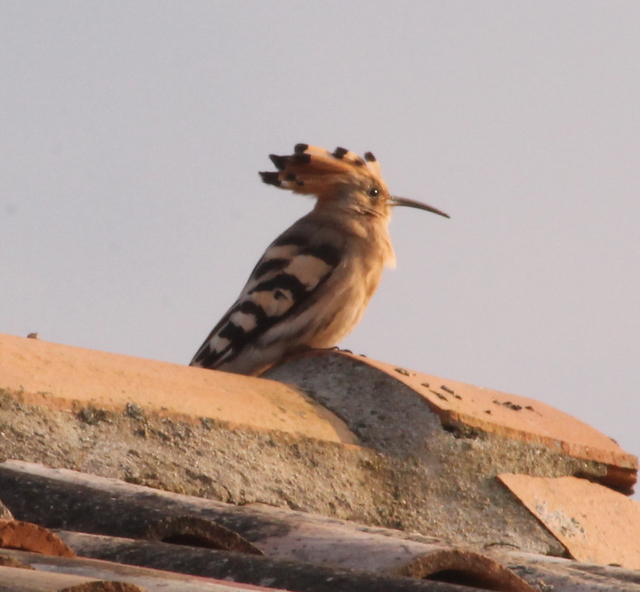
We are looking for a rose to act as centrepiece where the biggest spruce one stood…
you’re one looks just the ticket…
we’ve left 3mtrs of the spruce in place with a ring of branch ends to attach string/wire to totrain a rose up.
It is right outside the front door of the longére where guests stay…
so would be perfect.
Your Fremontodendron just looks lonely…
how about some Cosmos sulphureas underneath…
the colours would complement…
and some daffs/narciss for the start of the year…
just a thought.
And what’s the stripey bee in the first picture, please…
or is it something else…
some sort of clearwing moth, perhaps?
Your Viburnum looks like V. opulus to me…
the Guelder Rose….
native, but not common…
and a fantastic pland for the birds….
as well as being highly decorative all year.
LikeLike
For “pland” read “plant”…
the keys aren’t even near each other!!
LikeLike
The stripey bee is a female Halictus scabiosae, I think. You are right about the Fremontodendron but I just don’t want to keep adding to much as it is more difficult to maintain and mow but it does look lonely. It’s not a V. opulus, I’ve got one of those. They are very common around here and they are called Boules de Neige. I don’t mind too much that it doesn’t have a name. Amelia
LikeLike
Lovely to see the unfolding of the season in your garden. The bee orchid is so deceptive; I really thought it had bees on it. The hoopoe reminds me of my time in Botswana; loved watching them.
LikeLike
Thank you. I’m glad you like the hoopoe, the animals you see often bring back happy memories. Amelia
LikeLike
the viburnum looks like maresii to me, is it growing in wedding cake layers? Fremontodendron are usually grown as a climber so it will look better when there is more of it and it becomes more self supporting, otherwise it is good grown against a house wall, be careful when pruning it, the fine hairs on the stems and leaves can cause respiratory problems.
LikeLike
V. maresii [Japanese Snowball] has the same leaves as V. bodmantense….
simple and ridged… like a crinkle-cut crisp…
but the flowerheads are like those above…
however, the leaves of the ones pictured here are smooth, tri-lobed….
like V. opulus.
Guelder Rose [V.opulus] has wonderful Autumn colour and the birds love the berries.
LikeLike
Thanks for the information! I haven’t pruned the Fromontodendron yet. I think it would look better against a wall. This may be a project for the autumn because I feel it is a plant in the wrong place. I’ve checked out Google images and I think the viburnum is a maresii but it is still too young it hasn’t developed its mature form but I’m going to look after it better now as I liked the shape of it. thanks. Amelia
LikeLike
Woops! Sent my reply to the wrong person! I’ve just checked the leaves of the viburnum and they are more like little liriodendron leaves i.e. 3 pointed and three leaf stems join the main stem at the same point. So the leaves ore not like maresii. I thought that was the correct name as the name on the label ended with an -ii but I could not read the hand-written beginning. I do like the idea of growing the fremontodendron against a wall, it seems as if it is lacking something and it could be a wall. A project for the autumn. Amelia
LikeLike
I had not appreciated how beautiful your house walls are before, the Rose looks gorgeous up against the house. Does your Viburnham have a lobed leaf, like a Guelder rose? I also really like the white Aquilegia, it’s really elegant.
LikeLike
Thank you, I think Christina has solved the mystery and my Viburnum is a maresii! I’m very happy about that as it looks as if it should be a nice shape when mature. Amelia
LikeLike
Beautiful photos! I’m jealous that you’ve got Ophrys. They’re cool on several levels. It’s impressive to grow a tree from seed, which sounds boastful now that I think about it because I have a trio of small paw-paws I started that way. That third columbine is great. I don’t think I’ve seen one like it before. And a Hoopoe!
LikeLike
I think there is something special about growing a tree from seed. It is not always practical, of course, and better done with fast growing species! I don’t know what Paw-paw trees look like, they sound tropical. Amelia
LikeLike
You have such wonderful variety in your garden! I love the bee orchid, I have only ever seen one once, that was in Kent on chalk grassland and it had been covered with a wire cage for protection. As for the Hoopoe, I look at the pictures in my bird books and dont expect to see one.
LikeLike
I was very pleased when the orchid reappeared again this year. Very fitting to have a BEE orchid in my garden :). Amelia
LikeLike
Your garden is the perfect place for the bee orchid! Philip
LikeLike
I read this as I watch the snow swirl about, pushed by gusty winds. I fear for many of the little birds, and especially the hummingbirds.
Glad it’s Spring somewhere, but I’m not even thinking of Summer right now.
LikeLike
I thought you must be in spring by now! The flowers and the wildlife must be having a tough time this year. Amelia
LikeLike
There’s a little church in Paris with a plaque dedicated to the olive tree. It explains that the olives are famous and productive in the Mediterranean climates, but rarely further north. The difference is often presumed to be the cold–but that’s not it. The problem is that the more northern areas has spring rains–apparently the olive is not an easy pollinator and the rains wash away the pollen before it can set fruit. If more northern folks want olives, they may have to consider les parapluies d’olives!
LikeLike
That’s interesting! I don’t think we usually get too much rain in the spring and I think this year there were plenty of warm dry days for pollination to take place. Amelia
LikeLike
Lovely!
LikeLike
Thank you, 🙂 Amelia
LikeLike
It’s great to have orchids in the garden and the bee orchid is really unusual. I don’t think I’ve ever heard of it.
I can’t see the leaves but the flowers on that viburnum look just like those on our hobblebush (Viburnum lantanoides), which is just starting to bloom now.
LikeLike
I just went out and checked the leaves as the flowers looked so similar but they are 3 pointed and come out of the stem three leaves at a time. It looks like a little liriodendron shaped leaf so it can’t be that one. I have never seen the bee orchid in the woods here but I’m not as good at spotting things as you are! Amelia
LikeLike
It sounds more like maple leaf viburnum (Viburnum acerifolium).
LikeLike
dromfit has found a Viburnum trilobum that matches the leaves and flowers. I had no idea how many Viburnums there could be! Amelia
LikeLike
I thought I recognized that yellow flowering tree. It’s the California flannel bush/tree. This one is special to me because it reminds me of where I grew up. How interesting to find it growing in your lovely climate clear across the Atlantic.
LikeLike
Once again it’s gardeners that have brought it over, you will only find it in nurseries here. I knew it was from California and thought it might like it here and tolerate dryness in the summer. Amelia
LikeLike
Loved the latest post. We have been enjoying sunshine——global warming I suspect. The rhododendron and azalea are making a great show this spring. All the blossom has been special.
As I write we are sipping wine on the porch and its close to 7:00 pm and 76 degrees f. Unheard of for here. I’ll take it.
Our mason bees are buzzing in profusion, I am reading that I need to collect the cocoons in fall and wash them to remove mites, then store in the refrigerator until spring. I need to read more. I suspect our climate lets them survive over winter, but I guess the houses need cleaning.
I found 2 fancy houses in the thrift (secondhand) store for $2.50. Just looked in line and they are pricey! they are almost filled. 🙂
Just a few more things to sort out for the trip. 🙂
Love Annie
Love Annie. Sent from my Windows Phone
LikeLike
There is a lot of debate over whether you need to clear out any mites or other parasites or leave it up to nature. I have left mine as they have also chosen to nest in solid wood holes so I couldn’t clear those out. Some people use paper tubes and I must admit they seem a good idea if you can get yourself set up to do it that way. Your weather sounds good and we are getting it mild here too. I hope it continues like this into the summer. Amelia
LikeLike
Mme Isaac looks like what one calls an ‘old-fashioned rose’, of the sort that are hard to get nowadays, if at all. Was it there when you moved in (lucky you) or did you plant it? And that’s the second hoopoe posted in as many days – the other is in the UK (Flamborough!). Just about to set off to France on a wine run for our son’s wedding next month… very excited! RH
LikeLike
An adventurous Hoopoe in the UK! My rose is a commercial rose and not difficult to get, I got it from Andre Eve who has a very good reputation in France. All the plants I have got from them have been good. Exciting times indeed! I hope you get a nice day for the wedding nest month. Amelia
LikeLike
I think I’ve found it….
Viburnum trilobum [also known as V. opulus trilobum]…
American Cranberrybush Viburnum, American Cranberrybush, Kalyna or Highbush or High Bush Cranberry…
apparently the berries are edible… but to my understanding those of V.opulus are poisonous…
[The Wikipedia article is here: http://en.wikipedia.org/wiki/Viburnum_trilobum ]
The French Canadians even have a name for the berry… Pembina…
the Ukranians call it Kalyna… but surely that must refer to V.opulus??
LikeLike
I’ve checked the Wikipedia images and they seem to match, so I think you’ve found my species. I think it must have had another name that finished in a “ii” which could have been a further variety of it but the photos certainly look identical. Thanks.:)
LikeLike
You are living in a paradise, Amelia, and good of you to share it with us. By the way, I just mentioned you in a post of mine about bees, and hope that is ok.
LikeLike
I loved your post and it was so interesting to find out what people are doing in Norway. Amelia
LikeLike
Amelia,
Pauline and I have just listened…
on iPlayer…
to an amazing BBC “Living World” programme about Osmia bicolor…
it was called “A Shell Nesting Bee” and the link is:
http://www.bbc.co.uk/programmes/b043w5t7
I wanted to put this on your Bee Blog…
but I’m on the laptop, and there isn’t a link on this site to the other…
not one that I can find, anyway.
Enjoy the listen, it was fascinating!!
LikeLike
Thank you for that. I will listen once the family have finished their holiday. I would love to have some of the snail shell nesting bees in my garden, I have been saving the snail shells and that reminds me I should put them out now (you never know :)). Amelia
LikeLike
Lovely colours, and what a handsome Hoopoe! I love that you’ve taken a little bit of Guildford to France. 😀
LikeLike
I hope it gets on with all the French Acacias here! Amelia
LikeLike
What a beautiful garden you have. So much variety, of plants and wildlife. We have a multi-stemmed robinia in our garden. It’s flowering beautifully right now, although the wood pigeons always peck off a very large number of the flowers. I prefer the wild, green sort to the golden sort.
LikeLike
I think the flowers could be tasty. I’ve heard you can put fresh Acacia flowers inside crepes. They certainly smell good enough to eat. Amelia
LikeLike
PS the hoopoe is delightful.
LikeLike
Pingback: Heirloom Roses for Your Ohio Garden